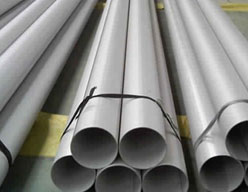In the world of industrial piping, the demand for highly corrosion-resistant alloys continues to grow. One standout material in this field is the 254 SMO pipe—an austenitic stainless steel alloy known for its excellent resistance to pitting, crevice corrosion, and stress corrosion cracking. As more industries like chemical processing, offshore drilling, and desalination adopt this super austenitic alloy, welding techniques and best practices become increasingly important. This blog will guide you through the welding characteristics of 254 SMO pipes, discuss challenges you may face, and offer tips for successful fabrication—while also helping you understand what to look for in 254 SMO Pipe Suppliers.
What is 254 SMO Pipe?
254 SMO (UNS S31254) is a high-alloy austenitic stainless steel with exceptional resistance to seawater and chloride-rich environments. It contains high levels of molybdenum (6%), chromium (20%), and nitrogen, offering mechanical strength and resistance far superior to that of 300 series stainless steels.
Due to its premium properties, 254 SMO pipes are commonly used in:
- Chemical processing plants
- Pulp and paper industries
- Desalination systems
- Offshore oil platforms
- Heat exchangers and condensers
Given its composition, 254 SMO demands special attention when it comes to welding and fabrication.
Why Welding 254 SMO Pipe Requires Expertise
Unlike standard stainless steels, 254 SMO’s high-alloy content makes it more sensitive to heat input, which can affect its corrosion resistance if not properly managed. Poor welding practices can lead to:
- Intergranular corrosion
- Loss of strength
- Cracking or porosity
- Decreased pitting resistance
That’s why both end users and 254 SMO pipe suppliers often emphasize correct welding techniques to preserve the material’s integrity.
Pre-Welding Preparation: What to Keep in Mind
Before any welding begins, proper preparation is essential:
1. Clean Surfaces Thoroughly
Use a stainless steel wire brush to clean the area to be welded. Remove oil, grease, or contaminants that may cause weld defects.
2. Avoid Cross-Contamination
Ensure that tools used for carbon steel are not used on 254 SMO to avoid ferrite contamination, which can reduce corrosion resistance.
3. Joint Preparation
Ensure smooth and uniform joint edges. Due to the metal’s toughness, mechanical cutting methods like plasma cutting or water jet are preferred.
Suitable Welding Techniques for 254 SMO Pipe
1. GTAW (TIG Welding)
Gas Tungsten Arc Welding is often the preferred method for welding 254 SMO pipe. It provides excellent control over heat input, which is critical to preserving the alloy’s corrosion resistance.
Tips:
- Use a low heat input
- Employ a short arc length
- Ensure a protective argon gas environment
2. SMAW (Stick Welding)
Shielded Metal Arc Welding can be used for larger, thicker sections. However, this method should be executed by skilled welders to avoid cracking or fusion issues.
Tips:
- Choose the correct electrode (typically E NiCrMo-3)
- Maintain interpass temperature < 100°C
3. GMAW (MIG Welding)
While less common, MIG welding can be used for 254 SMO pipe in some applications. It is faster but harder to control than TIG, so it’s usually limited to less critical joints.
Recommended Filler Materials
Matching the filler material to the base metal ensures consistent corrosion resistance. Common filler options include:
- ERNiCrMo-3 (Inconel 625)
- ERNiCrMo-4
- AWS A5.14 filler wires
- Avesta 625 or 2553 for thick-wall applications
Consult with experienced 254 SMO Pipe Suppliers to source appropriate filler metals, as not all filler rods or wires perform equally in chloride-rich environments.
Welding Challenges with 254 SMO Pipe
1. Risk of Hot Cracking
Due to its low carbon and high alloy content, 254 SMO is prone to hot cracking if welded improperly.
Solution: Keep heat input low and avoid high interpass temperatures.
2. Distortion
Because of its high thermal expansion coefficient, 254 SMO can warp or distort during welding.
Solution: Use proper fixturing and balanced weld sequences.
3. Loss of Corrosion Resistance
Overheating can deplete molybdenum or chromium near the weld zone, weakening the alloy’s corrosion resistance.
Solution: Strictly monitor welding temperature and post-weld cooling.
Post-Welding Treatment
To restore full corrosion resistance, post-weld cleaning is crucial. Steps include:
- Pickling and Passivation: Removes heat tint and restores the passive layer.
- Mechanical Grinding: For aesthetic and dimensional correction.
- Hydro Testing: Ensures integrity under operating pressure.
For critical industries like offshore oil or desalination plants, it’s wise to consult 254 SMO Pipe Suppliers who also offer welding support and post-fabrication testing.
Choosing the Right 254 SMO Pipe Suppliers
Welding success doesn’t only depend on technique—it also hinges on the quality of material. Here’s what to look for in a supplier:
- Certifications: Look for ASTM, ASME, or EN standards compliance.
- MTRs (Mill Test Reports): Ensure chemical composition and mechanical properties.
- Stock Availability: Leading suppliers offer a variety of sizes and wall thicknesses.
- Welding Support: Some top-tier suppliers also provide welding recommendations or value-added services.
Reputable 254 SMO Pipe Suppliers like these can help you get the right pipe, filler, and fabrication guidance all in one place.
Conclusion
Welding 254 SMO pipe is not a task for beginners. It requires attention to detail, the right tools, and an understanding of the material’s limitations and strengths. With the correct welding method, filler material, and post-weld treatment, 254 SMO pipes can deliver superior performance even in the harshest environments.
Whether you’re planning a chemical processing plant, an offshore platform, or a high-performance cooling system, choosing experienced 254 SMO Pipe Suppliers and following best welding practices will ensure structural integrity, corrosion resistance, and long-term success.



